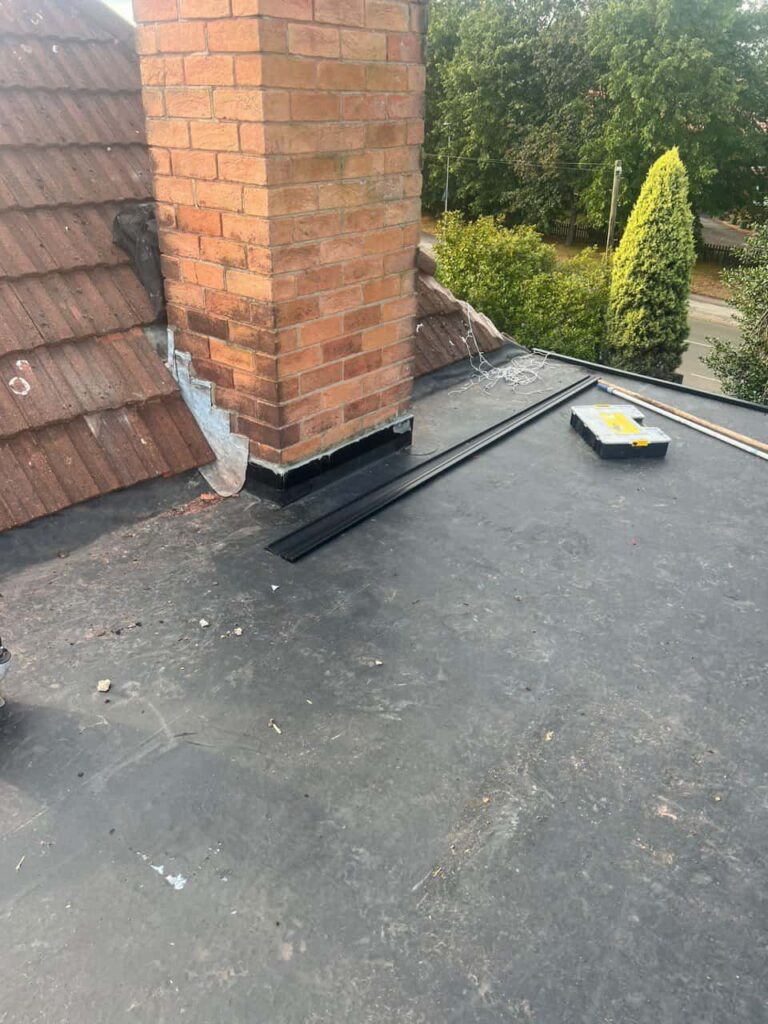Flat roofs are a popular choice for both residential and commercial properties due to their modern look and practical design. However, they require consistent and proper maintenance to ensure they drain effectively. Without adequate drainage, flat roofs can experience a host of problems, from water pooling to structural damage. At Nuneaton Roofing Repairs, we specialise in maintaining and repairing flat roofs in Nuneaton, Warwickshire, ensuring that they remain functional and safe throughout the year. In this post, we’ll explore the hidden dangers of poor drainage on flat roofs and how to prevent them.
The Importance of Proper Drainage on Flat Roofs
Flat roofs, despite their name, are designed with a slight slope to allow water to drain off effectively. Proper drainage is essential for avoiding water accumulation, which can lead to costly repairs and damage to your property. Unlike pitched roofs, where rainwater naturally runs off, flat roofs rely on carefully designed drainage systems, including outlets, downpipes, and gutters, to remove water quickly and efficiently.
Hidden Dangers of Poor Maintenance and Drainage
- Water Pooling
Water pooling, also known as ponding, is one of the most common issues associated with flat roofs. When drainage is poor or blocked, water can collect in low areas of the roof, leading to standing water. Over time, this can cause leaks, degrade the roof’s surface, and put additional stress on the structure, leading to sagging or even roof collapse in extreme cases.
- Roof Leaks and Water Ingress
Standing water that remains on the roof for extended periods increases the risk of leaks. Even the smallest cracks or imperfections in the roofing material can allow water to penetrate, leading to water ingress. Over time, this can cause dampness, mould growth, and internal damage to ceilings and walls. If left unaddressed, water ingress can weaken the structural integrity of the roof and the building itself.
- Moss, Algae, and Plant Growth
Flat roofs that do not drain properly are prone to moss, algae, and even plant growth. Moss and algae thrive in damp conditions, and their presence can cause further damage by trapping moisture against the roof’s surface. Roots from plant growth can also penetrate roofing materials, leading to cracks and leaks. Regular cleaning and maintenance can help prevent these issues and keep your flat roof in good condition.
- Damage to Roofing Membranes
Water pooling and prolonged exposure to moisture can weaken roofing membranes, which are designed to provide a watertight barrier for flat roofs. Over time, the membrane may blister, crack, or peel, leading to leaks and further damage. Once the membrane is compromised, the roof’s ability to protect against water ingress is significantly reduced, requiring immediate attention to prevent costly repairs.
- Structural Damage
When flat roofs are not draining correctly, the excess weight of water pooling can put immense pressure on the roof’s structure. Over time, this can cause sagging or, in the worst cases, structural failure. This is particularly dangerous during the winter months when standing water can freeze, further exacerbating the weight and pressure on the roof.
How to Ensure Your Flat Roof Drains Properly
- Regular Inspections
One of the best ways to prevent drainage issues is to schedule regular roof inspections. A professional roofer can identify potential problems such as blocked drains, damaged roofing membranes, or areas prone to water pooling before they escalate into major issues. At Nuneaton Roofing Repairs, we recommend inspecting your flat roof at least twice a year—before and after the winter season.
- Clear Gutters and Downpipes
Clogged gutters and downpipes are common culprits for poor drainage on flat roofs. Leaves, debris, and dirt can build up over time, preventing water from flowing off the roof efficiently. Ensure that your gutters and downpipes are regularly cleaned to maintain proper drainage, especially after heavy storms or during the autumn when leaves fall.
- Check for Damage or Wear
Flat roofs can develop cracks, holes, or wear over time, particularly around seams and joints. These areas are more prone to leaks, especially if drainage is poor. If you notice any signs of damage, such as cracks, blisters, or peeling membranes, it’s essential to have them repaired as soon as possible to prevent water ingress and further deterioration.
- Ensure Proper Sloping
While flat roofs are nearly level, they should have a slight slope to allow water to drain effectively. If your roof is completely flat or has areas that consistently collect water, it may require re-sloping or additional drainage outlets to improve water flow. A professional roofer can assess your roof and recommend solutions to ensure proper drainage.
- Install Roof Drains or Scuppers
In some cases, flat roofs may benefit from additional drainage systems such as roof drains or scuppers. These systems help direct water off the roof and into the guttering system, preventing water pooling and ensuring efficient drainage. If your flat roof consistently experiences drainage issues, installing additional drains can provide a long-term solution.
Conclusion
Flat roofs require regular maintenance to ensure they drain properly and remain free from water damage. Without adequate drainage, issues such as water pooling, leaks, and structural damage can quickly develop, leading to costly repairs. At Nuneaton Roofing Repairs, we provide expert flat roof maintenance and repair services to keep your roof in top condition. If you’re concerned about your flat roof’s drainage or need professional maintenance, contact us today for a thorough inspection and reliable roofing solutions in Nuneaton, Warwickshire.
Call us on: 024 7542 4593
Click here to find out more about Nuneaton Roofing Repairs
Click here to complete our contact form and see how we can help with your roofing needs.

